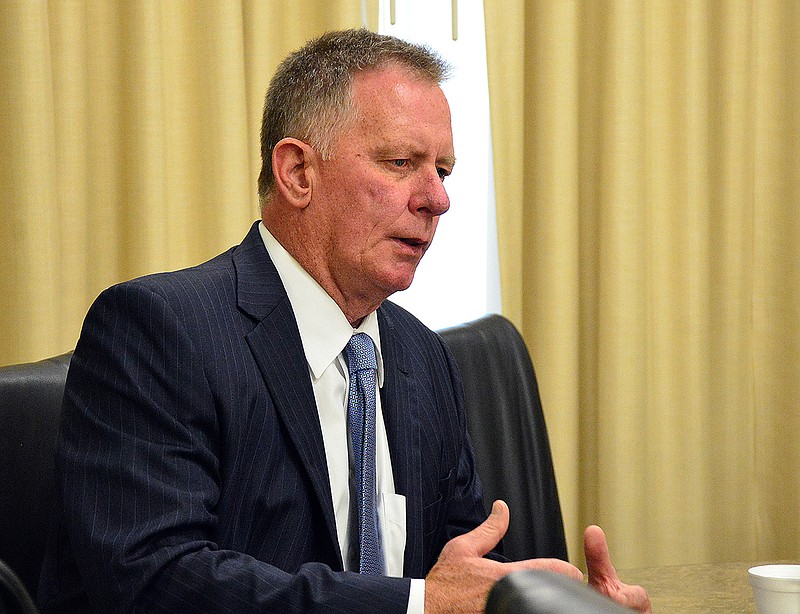Missouri's employers might begin to leave the state because of a shortage of workers, consultants for a statewide workforce report said Tuesday.
The Missouri Chamber of Commerce and Industry released a report Tuesday that studied the challenges the Missouri workforce faces over the next decade. In 2015 the chamber began a a 15-year plan designed to create improvements to the state's workforce, infrastructure and business climate.
Tuesday's report found that even if the state can retain every student who graduates from high school and college over the next 20 years, Missouri is expected to face a shortage of 200,000 workers.
Consultants and chamber employees said they think getting students interested in industries earlier and retraining workers will be key to fending off the problem.
Between 1990-2016 Missouri's population of people over age 45 grew by 52 percent, the study found. The state's population of people ages 25-44 declined during that time frame. Over the next 20 years, 1.6 million workers ages 45-64 will retire.
The study found that even if Missouri can retain every high school and college graduate in the state, just 1.4 million people will come into the pipeline.
"It's not just that we can't find people with the right skills," said Ted Abernathy, a managing partner at Raleigh, North Carolina-based consulting firm Economic Leadership. "We can't find people."
Today Missouri ranks No. 30 nationwide in job growth, the study found. Missouri's workforce grew at a rate of just 1 percent between 2000-15. That's expected to slow to a rate of 0.2 percent over the next seven years.
"Recovery has been uneven, with many parts of rural Missouri yet to return to pre-recession job levels," the study notes.
Attracting workers is one option to replace workers the state can't mine on its own. That remains a challenge, the study says, because increasingly population growth is being concentrated among a small number of cities nationwide.
To combat this, the study recommends creating a marketing campaign that touts Missouri's low cost of living and other benefits for workers. About 8,000 highly skilled workers leaving the military each year, the study says, and they're a prime target to recruit.
A skills gap makes it harder for employers already here to find employees with the right skills. About 53 percent of Missouri jobs fall into the mid-skill category, but only 46 percent of workers possess the skills needed for these jobs. Many of these jobs - like diesel mechanics, truck drivers and CNC operators - are not promoted to teachers and students.
The study recommends schools and employers better convey the benefits of these jobs to teachers and students. Conveying the importance of soft skills like honesty, dependability and professionalism will help, the study noted. This type of outreach work also requires working collaboratively with the Missouri Department of Elementary and Secondary Education to convey these skills, the report says.
"In today's economy (children) are likely to have personal interaction with nurses, teachers and lawyers but less likely to encounter those in manufacturing and technical fields," the report says.
Throughout the lives of the next generation of children, Abernathy said, workers will need to be able to be flexible and adapt. The study notes 65 percent of jobs do not exist for children who entered kindergarten in 2017.
Specialized schools, like schools that teach truck drivers only trucking skills, already exist, Abernathy said. Businesses also are creating their own programs to retrain workers.
Karen Buschmann, Missouri Chamber vice-president of communications, said Toyota created a program in Kentucky to train Toyota workers. State Technical College of Missouri partnered with Toyota to lead a similar pilot program at the Toyota-Bodine Aluminum factory in Troy, Missouri, Buschmann said.
Since then, the program has attracted other business partners. Buschmann hopes the program eventually will expand to other parts of the state.
"It's not just Toyota that's benefiting from this," Buschmann said. "We have eight to 10 manufacturers that are also participating."
Shelle Jacobs, Missouri Department of Corrections re-entry coordinator, said the DOC recently began offering inmates the chance to earn a National Career Readiness Certificate, which can help them get jobs once they are released from prison.
The DOC now offers the program at the Algoa Correctional Center, Boonville Correctional Center and Vandalia Correctional Center. Jacobs said these former offenders can contribute to the state's workforce.
"We release 19,000 offenders every year," Jacobs said. "We need to employ these people so they don't re-offend and go back to jail."
As the the state's economy evolves over the next decade, Abernathy said, it will become more automated. Workers will still be needed, though. If employers can't find employees, they will leave, he said.
"The availability of top talent is going to be one of the top things that drives (businesses') investment decision," Abernathy said. "That's the issue."

